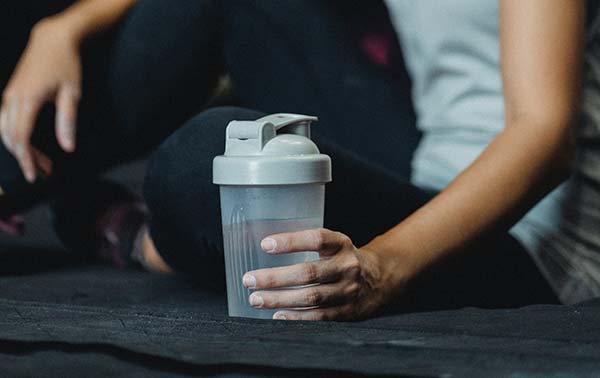Blog
How to Recover After a Workout
Learn how you can reduce muscle soreness and bounce back faster from your training sessions.
Learn how you can reduce muscle soreness and bounce back faster from your training sessions.

If you want to reduce muscle soreness and bounce back after tough training sessions with ease, then knowing how to recover after a workout is extremely important.
Because dragging through your workouts day after day isn’t fun. And neither is waking up sore in places you didn’t even know existed.
Here’s what you can do to speed up your recovery and stay on track with crushing your fitness goals:
Hydrate: Make Sure to Drink Plenty of Water
How to recover after a workout starts with making sure you’re hydrated. You want to make sure you’re drinking plenty of water leading up to, during, and especially after your workout.
Drinking water can help rid your body of lactic acid buildup (which causes muscle soreness), flush out any other toxins, prevent muscle cramps, and even make for healthy joints.
The American Council on Exercise recommends rehydrating with 16 to 24 ounces of fluid for every pound lost during exercise. For example, if you stepped on the scale after a workout and saw that you lost 2 pounds, you’d want to drink at least 4 cups of water to rehydrate.
If you don’t want to go through the hassle of having to weigh yourself after each workout, the “color check” is a quick way to tell whether or not you’re hydrated--all you have to do is make note of the color of your urine. Super simple: lighter-colored urine means you’re hydrated (by lighter, think lemonade-colored); darker urine (especially a burnt orange color) means you’re dehydrated and need to get some fluids in you ASAP.
When it comes to rehydrating, you’ll want to throw some electrolytes in there too for fluid balance. Minerals that can be found in most foods—like sodium, calcium, potassium, and magnesium—are all electrolytes.
Electrolytes help with nerve and muscle function, and they can even repair damaged muscle tissue.
Here are some foods high in electrolytes:
- Leafy green vegetables like spinach or kale
- Beans and lentils
- Fruits like bananas or prunes
What to Eat After a Workout
Did you know that lifting weights causes micro-tears in your muscle fibers?
A solid post-workout meal with an emphasis on protein and quality carbs can give your body the fuel it needs to repair those damaged muscle fibers and help your body recharge.
Protein contains amino acids that help repair damaged muscle tissue, while carbohydrates work to replenish your body’s glycogen stores.
Try to aim for a well-balanced meal within 1-2 hours after your workout.
Here are some food ideas for your next post-workout meal:
- Protein: chicken breast, white fish, egg whites, bison, tofu
- Carbohydrates: whole wheat pasta, brown rice, sweet potatoes, quinoa
- Veggies: broccoli, asparagus, cauliflower, spinach
- Fruit: strawberries, watermelon, apples, grapes
Eating to Build Muscle vs. Eating to Lose Fat
Depending on your fitness goals, the amount of food you’re eating will probably be a little different.
If you’re looking to gain muscle, then you want to be in a caloric surplus, which just means that you’re taking in more calories than you’re burning.
Conversely, if your goal is to lose fat, then you want to be in a caloric deficit, which means you’re burning more calories than you’re consuming.
Counting macros is an easy way to put yourself in either a caloric surplus or caloric deficit so that you can achieve your fitness goals
Workout Recovery Supplements
The list of supplements out there could go on and on, but here are a few of the more popular ones to help with muscle recovery after a workout:
- Protein supplements — This is an easy way to fuel up post-workout. You can buy your own protein powder and just make your own drinks or shakes. Some of the most common protein powders include whey, soy, or casein.
- Creatine — If your goals include boosting strength, muscle mass, or athletic performance, then creatine might be a supplement worth considering. Creatine is an amino acid found in both your muscles and brain that gives you energy during intense exercise or activity and has also been shown to help with recovery. You can get creatine from foods like seafood or red meat, but not at the levels creatine supplements can provide. It’s also been shown to positively impact your brain and may improve conditions such as Alzheimer’s or Parkinson’s disease.
- BCAA’s — Short for branched-chain amino acids. The three BCAAs (leucine, isoleucine, and valine) are considered essential amino acids, which means your body does not produce them naturally and you must get them through your nutrition. BCAA’s are taken to reduce exercise fatigue, reduce muscle soreness, and increase muscle mass. It seems like the verdict is still out on BCAA’s (considering you can get BCAA’s from things like protein supplements and other foods that are high in protein), but you might deem the potential benefits as reason enough to give them a try.
How to Recover After a Workout and Alleviate Muscle Soreness
Do you ever wake up the day after a tough workout and your muscles are so sore that you debate whether or not it’s worth getting out of bed? Especially after leg day?
That’s something called delayed-onset muscle soreness (or DOMS for short), which is caused by:
- Micro-tears in your muscles
Waste product buildup (such as lactic acid), which results in inflammation
A systematic review published in the Frontiers in Physiology found that active recovery following a workout can reduce the impact of delayed-onset muscle soreness.
Here are some active recovery methods you might want to consider adding to your post-workout routine.
Massage
Is there a more relaxing way how to recover after a workout than a good massage?
Not only do massages feel amazing, but they improve blood circulation, which makes it easier for your body and muscles to recover.
Foam rolling is a self-massage technique that can help with muscle tightness, and it’s an affordable alternative to a professional massage.

Ice Baths and Contrast Water Therapy
Ice baths (which fall under the contrast water therapy family tree) are another popular recovery tool to help you reduce muscle soreness and speed up recovery. With contrast water therapy, you alternate between hot and cold water in the shower.
The theory behind these two methods is that the cold side of things constricts your blood vessels, flushes out waste (like lactic acid), and helps to decrease swelling and tissue breakdown. The warm side of the therapy (i.e. getting out of the ice bath or turning on the hot water) increases your blood flow and circulation, which can help speed up the recovery process.
Sauna
Research has shown heat therapy (also known as hyperthermia) to help with muscle recovery. A study published in the Journal of Applied Physiology found that saunas can generate more heat shock proteins, which help with muscle repair after a tough workout.
On top of sweating a lot more than normal, the higher temperature in a sauna causes your blood vessels to become more dilated. Similar to the warm side of contrast water therapy, as your blood vessels become more dilated, your blood flow and circulation increase. This can help tense muscles relax and lead to relief for sore muscles.
Cryotherapy
Cryotherapy is the new kid on the block when it comes to how to recover after a workout. It’s a muscle recovery technique that uses liquid nitrogen to create subzero temperatures.
You stand in a small enclosure and expose your body to these super cold temperatures (ranging anywhere between negative 200-300 degrees) for just a few minutes, then you’re done.
Benefits of cryotherapy include faster recovery after a workout and reduced inflammation.
Get More Sleep
Sleep is critical to your recovery, especially if you workout consistently. Not getting enough sleep can impair your body’s ability to produce human growth hormone, which helps with muscle recovery after a workout.
One study, in particular, examined the impact sleep can have on muscle growth and recovery. Participants in the study were separated into two groups — one group slept for 5.5 hours each night, while the other group got 8.5 hours of sleep each night.
Over the 14-day study, researchers found that individuals in the group that slept for only 5.5 hours each night lost 55% less fat and 60% more muscle mass when compared to the group that slept 8.5 hours each night. It’s worth pointing out that both groups followed a calorie-regulated diet.
Just how much sleep is optimal? According to the CDC, you should aim to get at least 7 hours or more of sleep each night.
If you’re struggling to break through a weight-loss plateau, have you focused on your sleep habits? A lack of sleep can impact so many other areas of your life besides muscle recovery and it could be what’s holding you back from losing the weight you want.
De-stress
When you think about how to recover after a workout, de-stressing probably doesn’t come to mind.
But when you’re stressed, your body becomes focused on responding to that stress, and everything else kind of just goes to the wayside, including muscle recovery.
A 2014 study published in the Journal of Strength and Conditioning Research took a look at how stress compromises your body’s ability to recover after a strenuous workout. The study found that lower levels of stress equated to better recovery, while higher levels of stress equated to lower recovery.
If you feel like pulling your hair out most days, try some deep breathing exercises, mindfulness meditation, or start a creative project to de-stress and relax your mind.
Mistakes to Avoid With Workout Recovery
Not Cooling Down After Your Workout
After your workout’s done, you might want to consider sticking around for another 10-15 minutes for a quick cool down. A cool-down can take many forms—from walking to dynamic or static stretching. Stretching is a simple and easy way to help your muscles recover.
Your cool down can vary based on your workout but the whole point of a cool down is to:
- Help regulate blood flow so you don’t get dizzy or lightheaded
- Reduce added stress on your heart by gradually bringing your heart rate back to normal
- Prevent injury and increase flexibility
- Help with muscle soreness and fatigue
Whatever you do, just make sure you’re not stopping cold turkey once your workout’s over.
Overtraining
At a minimum, you’ll want to wait at least 48 hours after a workout to train the same muscle groups again. In other words, that means never working out the same muscle groups on back-to-back days.
If your body is aching, fatigued, or telling you that you need rest, then listen to it.
Your body knows exactly what you need and oftentimes it’ll make it obvious.
Conclusion
This article should have given you some tips, tricks, and hacks on how to recover after a workout.
There’s a saying that muscles are torn in the gym and built during recovery. So keep in mind that your time away from the gym, while you’re resting and recovering, is when your muscles actually grow.
Here’s what you can do to help speed up the muscle recovery process:
Drink plenty of water throughout the day and make sure to rehydrate after your workout
Eat a post-workout meal that’s rich in protein and quality carbs within 1-2 hours after your workout
Check out supplements like protein or creatine to aid in workout recovery
Use active recovery methods like massage, water contrast therapy, or saunas to flush out lactic acid and relax tight muscles
Prioritize sleep and find ways to de-stress
Ensure you're cooling down after each workout and listening to your body to avoid overtraining!

About the Author
Chad Richardson is a freelance writer from Cincinnati, OH. It’s actually been rumored that Chad came out of the womb doing bicep curls, so it should come as no surprise that he enjoys creating content to help others get in shape and live healthier lives. When he’s not in the gym impersonating Arnold Schwarzenegger, you can probably catch Chad at a local bar with some friends, frustrated with his hometown Red Legs’ inability to stay above 500 for a whole season. His philosophy on life? Take action starting TODAY on that thing you’ve been putting off...Not tomorrow, next week, or whenever you feel motivated...A small step might not seem like much right now, but even small steps add up to a mile eventually.
